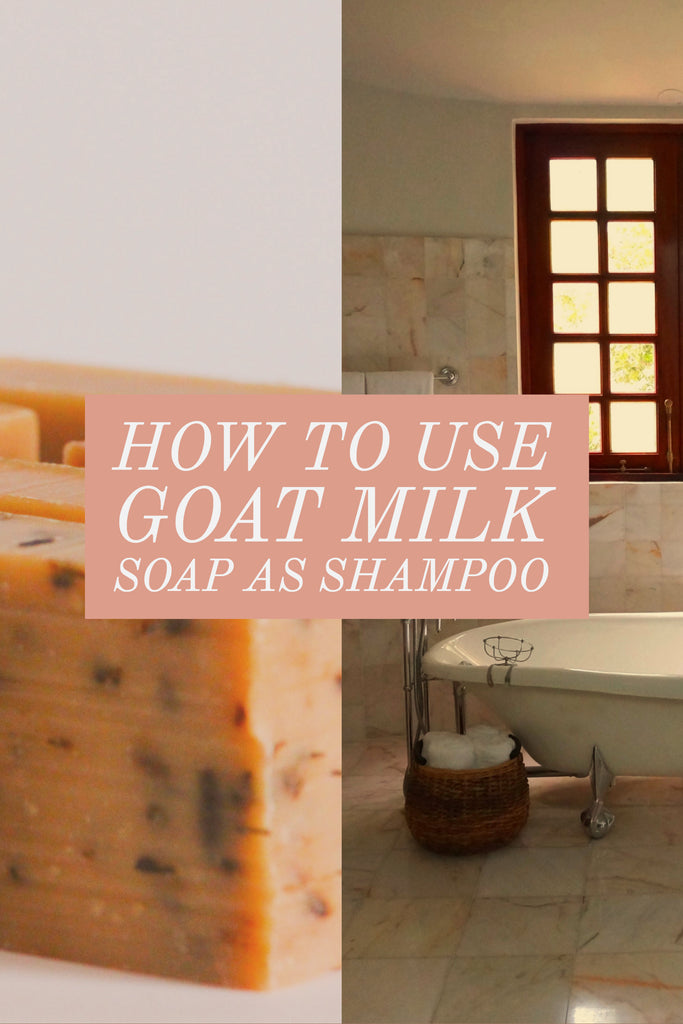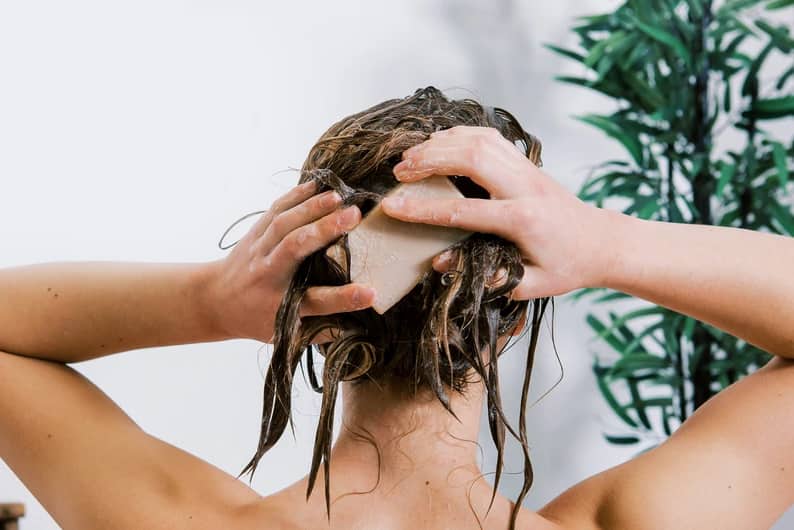You might’ve seen us mention this on social media, spotted it on a product review on our website, or caught mention of it in a blog post, but yes, in case you were wondering, the rumors are true: you can use ours bars of goat milk soap as an all-natural shampoo replacement!
And while some of you have already implemented this hair washing method into your daily life, others might be wondering…Why would I ever use a bar of goat milk soap as a replacement for my shampoo?
Here’s the thing: when we get into the habit of doing things a certain way — and are accustomed to using the same products over and over again — we may not see why we would want to switch up our routine. You probably didn’t think twice about the soap you were using until you tried a bar of goat milk soap and noticed the difference in how your skin looked and felt, right? The same idea applies to how we wash our hair.
"I love the tea tree bar soap. I actually use it to wash my hair... And it has normalized my scalp, leaving it not too oily, and without dry flakes!" - Customer testimonial
Haircare products are one of those household items that we often forget about when thinking about all of the ways we can integrate healthier, smarter products into our lives. Switching up your hair washing routine might not be something you’ve thought of, but we here at Bend Soap Company believe that it’s an idea worth trying out. Our goat milk soap has a great lather, effectively cleans the skin and hair (especially dry scalps), and will leave your hair soft.
Toxins in Shampoos
There’s more to using an all-natural shampoo bar than just soft hair and a healthy scalp. You’ll also be avoiding a variety of toxins and chemicals found in big-name brand shampoos.
Parabens
Parabens are added to products as a means to prevent the growth of bacteria, fungi, and yeast that can cause products to spoil. Unfortunately, they also bring a host of negative consequences. Parabens are derived from para-hydroxybenzoic acid, which occurs naturally in plants, but modern cosmetic products contain a chemically manufactured form that is far more dangerous than its natural version. We’ve got an entire blog post that dives deep on parabens which you can check out here.
Sodium Lauryl Sulfate (SLS)
Sodium Lauryl Sulfate (SLS) helps give soaps and shampoo products their lather. According to the EWG’s Cosmetics Database, it’s highly toxic. SLS carries a high concern for irritation of the skin, eyes, and lungs, as well as moderate concern for organ system toxicity.
Fragrance
On ingredient labels, the “fragrance” is often a catch-all term that can apply to a number of toxins and chemicals mixed together to create different scents. While manufacturers are not required to disclose which ingredients are listed in the “fragrance” listing on their ingredient labels, The International Fragrance Association has cultivated a list of 3,059 compounds that could be used in fragrances. Of those compounds, a significant number have been linked to cancer, reproductive toxicity, allergies and sensitivities, and other health issues.
Triclosan
Triclosan is a chemical often found in many soaps and personal care products. It’s not only used in products you put on your skin but is an active ingredient in many pesticides. This ingredient has been shown to “alter the way hormones work in the body”. As noted by Mayo Clinic, the Food and Drug Administration (FDA) declared in 2017 that triclosan is not generally recognized as safe and effective for antiseptic products intended for use in health care settings.
Propylene Glycol
Propylene glycol is another not-so-natural ingredient used in shampoo products. This petroleum-based ingredient is commonly used in low-quality cosmetic products as well as an antifreeze. In most cases, propylene glycol is used to extend the shelf life of a product by preventing bacterial buildup. While the full effects of propylene glycol are still under research, a few known concerns with propylene glycol include skin allergies, irritation, allergic reactions, and damage to the liver.
The Pros & Cons of Using Goat Milk Soap as a Natural Shampoo
For most of us, the thought of switching up the way we wash our hair can be daunting. There are different hairstyles, cuts, lengths, and textures that play a role in how we take care of our hair. Plus, everyone has different schedules for how regularly they wash their hair; some of you may wash your hair every day while others opt for a weekly washing (or longer) and stick with some type of dry shampoo product. But despite these variations in how we might wash and care for our hair, one thing is true for all of us: we all want a clean, healthy scalp and hair that’s free of excess oil.
Here are a few pros and cons of trying a bar of our goat milk soap as a shampoo:
Pros |
|
Cons |
|
The odds are in your favor! Here’s our recommendation: just give it a try! The worst possible outcome is that you wash your hair with a bar of our goat milk soap a few times, decide that you prefer your previous method, and then continue to use the bar of soap for your typical soap needs (as a body wash, face wash, dish soap, shaving cream, etc.).
Shake up the boring old way you’ve been washing your hair for years and try something new! Making the switch doesn’t have to be a major investment either. Grab a bar of our travel size goat milk soap for $2 or buy a whole bar for only $4.95. Plus, shipping costs for orders under $5 are only $2! Our friend Tiffany from Don’t Waste the Crumbs actually did an entire cost breakdown on using our goat milk soap as a shampoo for those who are interested.

How to Use Goat Milk Soap as Shampoo
The seven steps we’ve outlined below will set you up for success (and get your hair looking and feeling it’s best!)
Step #1: Choose a bar of goat milk soap
This is the fun part since there are no right or wrong scents to choose from. Try a new scent that will make washing your hair something you look forward to or stick with your all-time favorite. Our Tea Tree Goat Milk Soap has always been a popular scent used by our customers as a natural tea tree shampoo.
If you’re hesitant about having greasy hair during your transition, we recommend opting for our Unscented Goat Milk Soap as this bar doesn’t contain any essential oils (what we use to add fragrance to our soap) which, for some, is an ingredient that can be irritating to the scalp, resulting in the overproduction of oil. Experiment with the scents you choose… You'll find what works best for your hair type!

Step #2: Brush your hair
We recommend brushing your hair before you wash it (when it’s dry.) Investing in an ultra-soft boar bristle brush and massaging your scalp before washing will detangle the hair, remove oil buildup and product (like dry shampoo and hairspray), and lift away dead skin cells, ensuring that your hair and scalp are primed for optimal cleansing in the shower. This is a great idea for those who deal with dandruff, too!
Step #3: Rinse
Whenever we wash our hair, it’s important that we focus on the scalp. The pores on our head naturally produce an oil called sebum which is intended to prevent our skin and hair from becoming dry and protect it from elements such as wind, water, etc.
Rinse your hair with warm — not hot! — water before washing it. Hot water can actually strip too much of our skin's natural oils, causing your scalp to overproduce sebum and lead to greasy hair.
If you have long hair, it might take your scalp a few days to adjust as we’ve found that the scalp tends to over-excrete oils during the transition period. Thankfully, this is something our goat milk soap can fix! While everyone is different, many of our customers with naturally oily scalps have shared that using our goat milk soap as a shampoo helped regulate the amount of oil their scalp produced, resulting in hair that looks and feels better. We think this is due to the fact that the scalp doesn’t have to work so hard against our natural ingredients, but it’s just our assumption.
Step #4: Wash & massage
Grab your bar of goat milk soap and begin rubbing the bar of soap between your hands to generate rich, velvety lather. You can also rub the bar of soap directly onto your scalp and hair, it’s really just a matter of personal preference here. Next, gently massage the suds into your scalp, being sure to wash all areas of your head (don’t forget behind your ears!) and allowing the lather to run down the ends of your hair.

For many of us, our scalp overproduces sebum, causing our hair to look greasy and oily in appearance. This makes washing your scalp a critical part of keeping our hair looking its best — we want to find a balance between our natural oil and keeping our scalp and hair clean. Take your time with this step as our goal here is to remove oil and dirt from the scalp. A healthy scalp promotes healthy hair!
Step #5: Rinse again
Rinse the soap from your head. If you have longer hair, use your fingers to separate different sections of your hair to ensure all soap is washed off.
Step #6: Condition
If you are looking for a replacement to using your big-name brand conditioner, try rinsing your hair with an apple cider vinegar rinse after you wash your hair. Many of our customers apply our Unscented Goat Milk Lotion to the bottom ends of their hair as an all-natural conditioner. We also have a number of customers with curly hair who use our rich goat milk lotion as a nourishing leave-in conditioner. Other folks tell us that they just use the bars of goat milk soap as a 2-in-1 shampoo and conditioner treatment. Have a little fun and experiment with this step!
Step #7: Brush & style
Our hair becomes extremely fragile after it’s been washed (especially when hot water is involved) and many hair care professionals will tell you that it’s best to refrain from brushing it immediately after hopping out of the shower to avoid damage. After your hair is washed, let it air dry for as long as possible before brushing it to avoid unnecessary breakage.

Back to You
Like you, we care about what we put on our skin and prefer to use all-natural products whenever possible to avoid all the harsh and dangerous chemicals in so many “trusted name brand” products. That’s why our skincare products leave out the harsh chemicals that dry out your skin (scalp included!), mess with our hormones, and potentially cause cancer.
Once you compare some of the benefits of using goat milk soap as a shampoo to the outcomes you were seeing with your big name brand shampoo you were using, we think this shampoo alternative will be a switch you’ll be happy you made! What’s to lose? Your scalp and hair deserve healthy, safe, all-natural ingredients to help them look and feel their best! Give it a try. Shop our entire collection of goat milk soap here.
Sign up to receive regular Toss the Toxins emails with educational information and tips from your friends at Bend Soap Company.
More Posts to Enjoy
- Blog Post: DIY Natural Dish Soap
- Blog Post: How to Detox Your Armpits and Prepare for Natural Deodorant
- Blog Post: How to Step Up Your Moisturizer Routine
- Blog Post: The Best Products for Sensitive Skin
- Blog Post: Why You Should Ditch the Toxic Chemicals in Shaving Cream
- Blog Post: The #1 Thing Missing From Your Skincare Routine





1023 comments
Thank you for this topic. It is very important. Everyone please thank the owner of this site and the wonderful topic. Keep it up, creator
موقع غربيات
Is this soap good for use on scalp psoriasis?
I love Bend Soap products, I would just feel WAYYY more comfortable having this soap in a liquid version so I could use it as shampoo rather than the solid bar. I’ve long awaited this. I’m hoping the Bend Soap team can consider it.
I tried this, tired of all the empty bottles of shampoo and conditioner in the shower (husband wants a separate one for his dry scalp, I want something that won’t snarl my fine hair). The first couple of days my hair felt a bit “greasy” but I remember the instructions that it will take a couple of days for your scalp to adjust. On day three, my hair was clean, soft, and didn’t tangle even with NOT using a conditioner. My husband loved the Eucalyptus Spearmint travel size we got as a sample in our last order, and I did too. Yay! One bottle in the shower now instead of four and I’m glad we can purchase the travel size in that scent as it’s just the perfect size for rubbing directly on the hair (which for us gave us the most lather). LB in Brookfield IL
In answering another post: I have been using the unscented bar on my grandbaby, not sure exact age I started. as long as they’re laying back and you’re careful not to get the soap in their eyes, it works great!